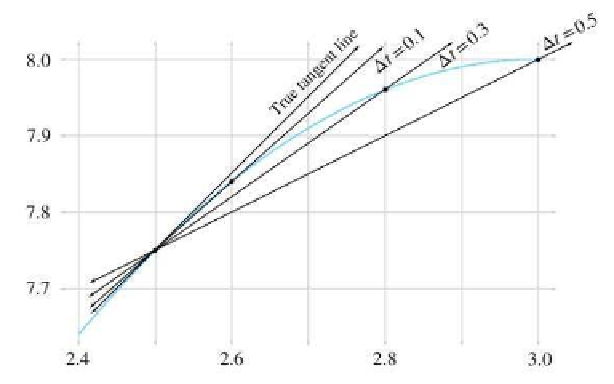Game Development Reference
In-Depth Information
Figure 11.5.
Approximating instantaneous velocity as the average velocity of a smaller and
smaller interval
Table 11.2
shows tabulated calculations for average velocity over intervals
with a right hand endpoint t + ∆t that moves closer and closer to t = 2.5.
The right-most column, which is the average velocity, appears to be
converging to a velocity of 1 furlong/minute. But how certain are we that
this is the correct value? Although we do not have any calculation that will
produce a resulting velocity of exactly 1 furlong/minute, for all practical
purposes, we may achieve any degree of accuracy desired by using this ap-
proximation technique and choosing ∆t su
ciently small. (We are ignoring
issues related to the precision of floating point representation of numbers
in a computer.)
This is a powerful argument. We have essentially assigned a value to an
expression that we cannot evaluate directly. Although it is mathematically
illegal to substitute ∆t = 0 into the expression, we can argue that for
x(t + ∆t) − x(t)
∆t
t
∆t
t + ∆t
x(t)
x(t + ∆t)
x(t + ∆t) − x(t)
2.500
0.500
3.000
7.750
8.0000
0.2500
0.5000
2.500
0.100
2.600
7.750
7.8400
0.0900
0.9000
2.500
0.050
2.550
7.750
7.7975
0.0475
0.9500
2.500
0.010
2.510
7.750
7.7599
0.0099
0.9900
2.500
0.005
2.505
7.750
7.7549
0.0049
0.9950
2.500
0.001
2.501
7.750
7.7509
0.0009
0.9990
Table 11.2.
Calculating average velocity for intervals of varying durations










Search WWH ::

Custom Search